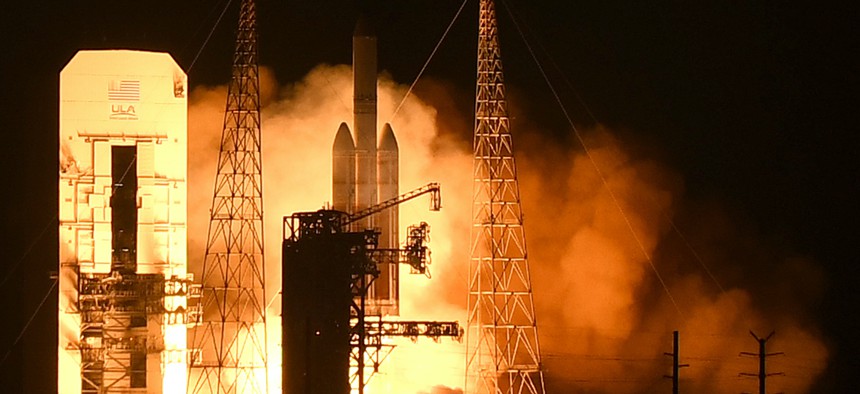
United Launch Alliance Delta IV-Heavy rocket launches from pad 37B at Cape Canaveral Air Force Station in 2020, carrying a classified spy satellite for the National Reconnaissance Office. Getty Images / Paul Hennessy/SOPA Images/LightRocket
US Military Satellites Need to Get Smarter, More Self-Reliant
Future satellites should understand their environment, act autonomously, and be less reliant on Earth for refuel, Space Command’s deputy commander says.
Predictive analytics and refuel-and-repair capabilities for satellites are some of Space Command’s key technology needs, a top official said Wednesday.
The command is charged with monitoring activity and debris in space, for the operation of military satellites as well as manned space missions. To do that—and to detect electromagnetic waveforms that could be signs of electronic warfare from adversaries—they’ll need new types of satellites or new capabilities for satellites, Lt. Gen. John Shaw, deputy commander of U.S. Space Command, said at the DARPA Forward event.
“Historically, we have typically done that mission set from mostly using sensors here on the planet,” he said.
The command is also seeking new types of AI software, deployable on satellites, to closely monitor electromagnetic noise or physical debris and watch for changes in “behavior.”
“There is the need to really understand…pattern of life of those active capabilities, and using the most predictive analytics to understand what may happen next, or to look for change detection in that environment.”
Intelligence officers might use the term “pattern of life” to describe the task of monitoring a potential terrorist target for days, weeks, months, or longer in order to truly determine if an individual posed a threat. Similar monitoring has now become necessary in space, due to new threats like Russia’s Cosmos 2543 satellite. Launched in 2020, the Cosmos 2543 satellite can shoot a projectile to destroy other satellites.
In 2017, a different Russian satellite also demonstrated advanced—and arguably predatory— space maneuvering when it changed its orbit to get close to an Intelsat satellite for reasons that remain unknown to Western observers.
Russia has also shown a willingness to use space as a war domain, such as in February when it launched a coordinated (but Earth-based) cyber attack against American satellite communications company Viasat in the minutes before launching its invasion of Ukraine.
Future satellites will also need to be much more autonomous, Shaw said.
“Because…of the vast volume and distances that we're operating in…platforms can't wait for human operators or even machines necessarily back on Earth to tell them what's going on and how to behave. They're going to need to probably do that autonomously. Whether that's maintaining orbits, avoiding debris, avoiding threats, and or finding the optimal ways to conduct their mission sets.”
The Defense Department will continue to need expensive satellites in higher—and more expensive—orbits. Said Shaw, a key priority is finding new ways to get fuel to them or limiting the amount of fuel they need.
“All of our satellites and spacecraft we send to space have taken their propellant with them. And they don't refill it or they don't refuel it,” he said. “We will continue to also have platforms in space that are capital assets and investments and we need to develop with that a complementary logistics structure in space that allows us to refuel to service and extend lifetime and extend capability. Right now our planners that are doing mission planning for many of our satellites on orbit have to use the constraints on their propellant in their calculations…I would love to take that out of the equation.”




